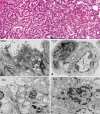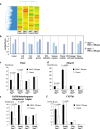Carcinogenicity of dimethylarsinic acid in Ogg1-deficient mice
- PMID: 17441966
- PMCID: PMC11158468
- DOI: 10.1111/j.1349-7006.2007.00475.x
Carcinogenicity of dimethylarsinic acid in Ogg1-deficient mice
Abstract
Oxidative stress to DNA is recognized as a mechanism underlying carcinogenic effects of some environmental agents. Here, we hypothesized that dimethylarsinic acid (DMA(V)), an organic metabolite of inorganic arsenic in humans, might exert carcinogenic potential in a mouse line carrying a mutant Mmh allele of the Mmh/OGG1 gene encoding the enzyme 8-hydroxyguanine DNA glycosylase 1 (OGG1). Ogg1 mutant and wild type mice were treated with DMA(V) in their drinking water at a dose of 200 p.p.m. for up to 72 weeks. All DMA(V)-treated Ogg1(-/-)animals developed tumors, with a tendency for lower total incidences in the Ogg1(+/+) cases. Lung tumors in particular were induced as compared to the lack in non-carcinogen controls and were significantly more frequent in the homozygotes. At week 4, the levels of DNA 8-OH-dG and cell proliferation were significantly elevated in the lungs of non-treated Ogg1(-/-) as compared to Ogg1(+/+) mice and were strongly enhanced by DMA(V) treatment. Marked induction of Pola1, Cyp7b1, Ndfua3, Mmp13 and other genes specific to cell proliferation, cell signaling and xenobiotic metabolism in the lungs of DMA(V)-treated Ogg1(-/-) mice was found. Electron microscopic examination revealed the growth of microvilli, with increased numbers of mitochondria only in lungs and lung tumors of DMA(V)-exposed Ogg1(-/-) mice. Therefore, we strongly suggest that DMA(V) exerts carcinogenicity in the lungs of Ogg1(-/-) mutant mice, with a possible role for persistent accumulation of DNA oxidative adducts.
Figures





Similar articles
-
Enhanced Susceptibility of Ogg1 Mutant Mice to Multiorgan Carcinogenesis.Int J Mol Sci. 2017 Aug 18;18(8):1801. doi: 10.3390/ijms18081801. Int J Mol Sci. 2017. PMID: 28820464 Free PMC article.
-
The role of trivalent dimethylated arsenic in dimethylarsinic acid-promoted skin and lung tumorigenesis in mice: tumor-promoting action through the induction of oxidative stress.Toxicol Lett. 2005 Aug 14;158(2):87-94. doi: 10.1016/j.toxlet.2005.03.009. Epub 2005 Apr 14. Toxicol Lett. 2005. PMID: 16039397
-
Carcinogenicity of dimethylarsinic acid in male F344 rats and genetic alterations in induced urinary bladder tumors.Carcinogenesis. 2002 Aug;23(8):1387-97. doi: 10.1093/carcin/23.8.1387. Carcinogenesis. 2002. PMID: 12151359
-
Methylated arsenicals: the implications of metabolism and carcinogenicity studies in rodents to human risk assessment.Crit Rev Toxicol. 2006 Feb;36(2):99-133. doi: 10.1080/10408440500534230. Crit Rev Toxicol. 2006. PMID: 16736939 Review.
-
Mammalian Ogg1/Mmh gene plays a major role in repair of the 8-hydroxyguanine lesion in DNA.Prog Nucleic Acid Res Mol Biol. 2001;68:107-23. doi: 10.1016/s0079-6603(01)68093-0. Prog Nucleic Acid Res Mol Biol. 2001. PMID: 11554290 Review.
Cited by
-
Progression of Hepatic Adenoma to Carcinoma in Ogg1 Mutant Mice Induced by Phenobarbital.Oxid Med Cell Longev. 2017;2017:8541064. doi: 10.1155/2017/8541064. Epub 2017 Jul 13. Oxid Med Cell Longev. 2017. PMID: 28785378 Free PMC article.
-
Pharmacokinetic and Genomic Effects of Arsenite in Drinking Water on Mouse Lung in a 30-Day Exposure.Dose Response. 2015 Jun 30;13(2):1559325815592392. doi: 10.1177/1559325815592392. eCollection 2015 Apr-Jun. Dose Response. 2015. PMID: 26674514 Free PMC article.
-
Cancer in experimental animals exposed to arsenic and arsenic compounds.Crit Rev Toxicol. 2010 Nov;40(10):912-27. doi: 10.3109/10408444.2010.506641. Crit Rev Toxicol. 2010. PMID: 20812815 Free PMC article. Review.
-
Risk assessment of small organoarsenic species in food.EFSA J. 2024 Jul 2;22(7):e8844. doi: 10.2903/j.efsa.2024.8844. eCollection 2024 Jul. EFSA J. 2024. PMID: 38957748 Free PMC article.
-
Enhanced Susceptibility of Ogg1 Mutant Mice to Multiorgan Carcinogenesis.Int J Mol Sci. 2017 Aug 18;18(8):1801. doi: 10.3390/ijms18081801. Int J Mol Sci. 2017. PMID: 28820464 Free PMC article.
References
-
- Anisimov VN, Alimova IN. The use of mutagenic and transgenic mice for the study of aging mechanisms and age pathology. Adv Gerontol 2001; 7: 72–94. - PubMed
-
- Kasai H. A new automated method to analyze urinary 8‐hydroxydeoxyguanosine by a high‐performance liquid chromatography‐electrochemical detector system. J Radiat Res (Tokyo) 2003; 44: 185–9. - PubMed
-
- Shibutani S, Takeshita M, Grollman AP. Insertion of specific bases during DNA synthesis past the oxidation‐damaged base 8‐oxodG. Nature 1991; 349: 431–4. - PubMed
Publication types
MeSH terms
Substances
LinkOut - more resources
Full Text Sources
Medical
Molecular Biology Databases
Research Materials
Miscellaneous

